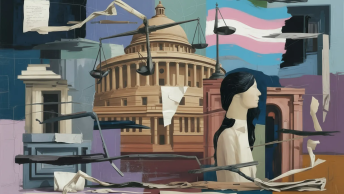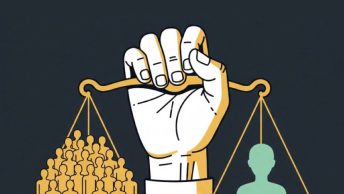The Supreme Court verdict on women’s entry into the Sabarimala Shrine is a watershed moment in the religious rights jurisprudence. In this post, I shall endeavour to thematically analyse the important doctrinal conclusions on the ‘Essential Practices’ test and its discursive impact on the constitutional jurisprudence. The majority opinions has largely relied upon this test to reject the claim of ‘Ayyappans’ that the exclusion of women between the age of 10 and 50 from entering the temple constituted an essential practice. The opinions of the majority follows the familiar set of tests, evolved by the precedents, that are required to be satisfied by a practice to claim protection. However, the manner in which the test has been administered by the three different opinions in majority by Dipak Misra J., Nariman J., and Chandrachud J., comes with slight qualitative difference necessitating separate analysis.
The Requirement of Unhindered Continuity
In order to arrive at his conclusion, Dipak Misra J. relied on the ‘proximate evolution’ and a ‘continuity in practice’ in question as a test. Misra J relied on the second Ananda Margi case to conclude that the practice of exclusion was never a continued existence and began only after the enactment of the subordinate legislation.. The Respondents arguments, in support of the ban on entry, on this issue was that until the enactment of the rules, it was loosely enforced. This, as per Misra J., goes to show that it is an ‘alterable part or practice’ that does not form “the ‘core’ of religion where the belief is based and religion is founded upon” (Paragraph 124). Also, while he holds that the practice does not possess any scriptural basis for claiming the right (Paragraph 124 Misra J.), the denial of the ‘essential practice’ status is importantly based on the finding that it does not have the ‘unhindered continuity.’
This reasoning, in my opinion, is a flawed understanding of the religious rights and it arises out of one of the major drawbacks in applying the essential practices test, that of self-assertion, such that a group in claiming the right can voluntarily choose to have a practice, which they may see as an essential part of their religion. Temporal continuity should not in any manner affect their freedom to fashion the religion the way they deem fit.
What is of importance is that this freedom is subject to the balancing by the court between other rights under Part III of the constitution. Rather than inquiring into the historicity and temporal continuity of the practice in question, the court should look at its impact on other rights and do the balancing act.
Equal Right to Worship
The opinion of Nariman J. is confounding in more ways than one. In the context of present discussion, his opinion while affirming the validity of ‘essential practices test’ does not reach any finding about the practice of exclusion in question. Bringing back Gajendragadkar’s expanded formulation of the test in Durgah Committee case to see whether a practice is essential to the religion or not, he observes that the extraneous and unnecessary accretions cannot be considered as essential part of religion. If it is ‘mixed up with secular activities the dominant nature of the activity test is to be applied. The Court should take a common- sense view and be actuated by considerations of practical necessity.’ (Paragraph 21.6). In spite of these doctrinal conclusions and agreement with the past precedent on the essential practices test, his opinion holds the ban on the entry of women as unconstitutional under Article 25(1).
The opinion enters into detailed discussion on the prohibitions against the participation by women in various religion solely on the notion of impurity attached to menstruation = Based on that he arrives at a conclusion that the fundamental right claimed by the worshippers of the institution, based on custom and usage under Article 25(1), must necessarily yield to the fundamental right of such women, as they are equally entitled to the right to practice religion (Paragraph 28). One cannot help but notice the unconscious balancing act between the conflicting rights and the claimers of those rights that is being done here. The question on requisite primacy between the individual rights of women to worship, against the group rights of the supporters of ban, has all been done without invoking other protections granted under Part III here. Also of great significance is his concomitant conclusion that as much as the worshippers of Ayyappa sees him as a celibate, it must yield to the rights of women to practice religion in the manner they deem it fit as per their conscience. In his own words,
“The fundamental right claimed by the Thanthris and worshippers of the institution… must necessarily yield to the fundamental right of such women, as they are equally entitled to the right to practice religion,” (Paragraph 29)
In Paragraph 28, after concluding that the ‘Ayyappans’ do not form a religious denomination under Article 26 to claim its protection, he proceeds to see whether they can claim the protection under Article 25 or not, even if one assumes that the ban forms an essential part of the religion. Contrary to his earlier observation that, whether a state action under 25(2)(b) can infringe even the essential practices can be tested only in a future case, he observes that ‘”since the said Act is clearly a measure enacted under Article 25(2)(b), any religious right claimed on the basis of custom and usage as an essential matter of religious practice under Article 25(1), will be subject to the aforesaid law made under Article 25(2)(b). The said custom or usage must therefore, be held to be violative of Section 3 and hence, struck down.:’ (Paragraph 28).
A Great Constitutional Moment
The opinion of Chandrachud is a complete and a welcome re-imagination of the religious rights under the Constitution. The jurisprudence until now has waded to an unnecessary depth foisting upon itself a responsibility to fashion the religion as it sees. A cursory look at all the precedents through which the essential practices test has evolved would reflect that the successive courts have merely attempted to prevent the disabilities arising out of denial of access in all its forms to social goods for individuals under the claim of group rights. However, process that led to this outcome has resulted in denial of the very essence of religious rights as recognized under Article 25 and 26 of the constitution with the court deciding on what may or may not constitute one’s religion. What is required to be done is an external inquiry on the impact that any practice could have on the other fundamental rights, a balancing act (See Paragraph 111). Commenting on this reversal Chandrachud J. observes that
“The assumption by the court of the authority to determine whether a practice is or is not essential to religion has led to our jurisprudence bypassing what should in fact be the central issue for debate … the basic question which needs to be answered is whether the recognition of rights inhering in religious denominations can impact upon the fundamental values of dignity, liberty and equality which animate the soul of the Constitution.” (Paragraph 109)
The very fact that the practice is predicated upon the physiology of women is a disability imposed upon them, which the Constitution seeks to prevent in its various forms. The reading of such a form of equality into Article 25 and 26, going beyond the traditional essential/non-essential dichotomy is a defining moment in the constitutional history. It is precisely this organic reading of the Constitution that can provide us its true meaning. Though the opinion of Nariman J. brushes on this aspect, it does not ground it with sufficient reasoning, confining it to Article 25(2)(b). In all, the opinion of Chandrachud J. though does not explicitly takes away the essential practices test, it has expressed sufficient doubts on its validity.
The Dissent
The dissenting judgment of Indu Malhotra J., though have arrived at a different conclusion on the case in hand, have some important observations in present context. In a tone that is rather similar to the opinion expressed by Chandrachud J. it observes that the court cannot determine the rationality of the religious beliefs or practises, ‘except if they are pernicious, oppressive, or a social evil, like Sati.’ (Paragraph 8.2). Rejecting the intervention of court under Article 25(2)(b) it states that
“Article 25(2)(b) is an enabling provision which permits the State to redress social inequalities and injustices by framing legislation. It is therefore difficult to accept the contention that Article 25(2)(b) is capable of application without reference to an actual legislation. What is permitted by Article 25(2) is State made law on the grounds specified therein, and not judicial intervention.” (Paragraph 10.8)
This is a diametrically opposite interpretation of the provision than the one offered by Chandrachud J. in his opinion. While it is acceptable that the court’s power to intervene in religious matters to the extent that it is prescribed under the essential practices test is understandable, to read down a provision such as Article 25(2)(b) to only mean a legislation is a rather regressive move in the constitutional jurisprudence. Similarly, the arguments of the Petitioners against the ban has been rejected at its threshold on the grounds of maintainability and that the findings made by the High Court when a challenge was made before it are final, only adds on to the reasoning insufficiency, in the face of an evolved understanding of the constitutional remedies at present.
The dissenting opinion attains a rather important position in that it makes the necessary delineation between the ecclesiastical matters where the court should not intervene. Crucially, it recognizes that the formation of a democratic society is a complex bargain that is arrived at between people representing various interested groups. Elements of shared identity, race etc. plays a formative role in such a process of coming together. The tests and qualifiers that the judiciary formulates either to define the scope of rights and protection that are accorded or to find whether they fall within the definition of who is accorded such rights and protection (in this case the essential practices test) are devised arbitrarily that would not legitimately permit such differing norms to admit themselves as a member of the recognize polity to whom it is extended. As it is noted in the dissent the crucial aspects of freedom to self identify oneself and considerations for possible variance are lost in the process.








Your article helped me a lot, is there any more related content? Thanks!
Thank you very much for sharing, I learned a lot from your article. Very cool. Thanks.